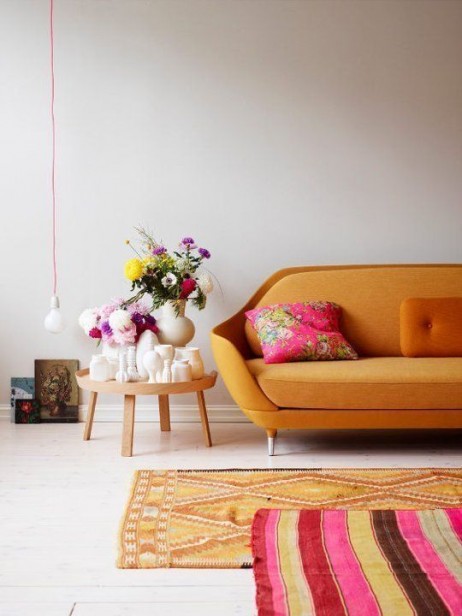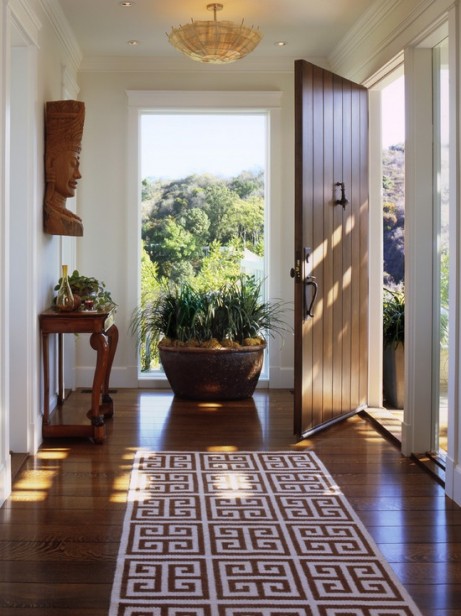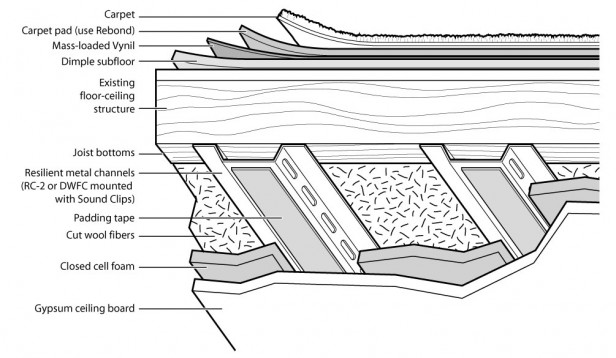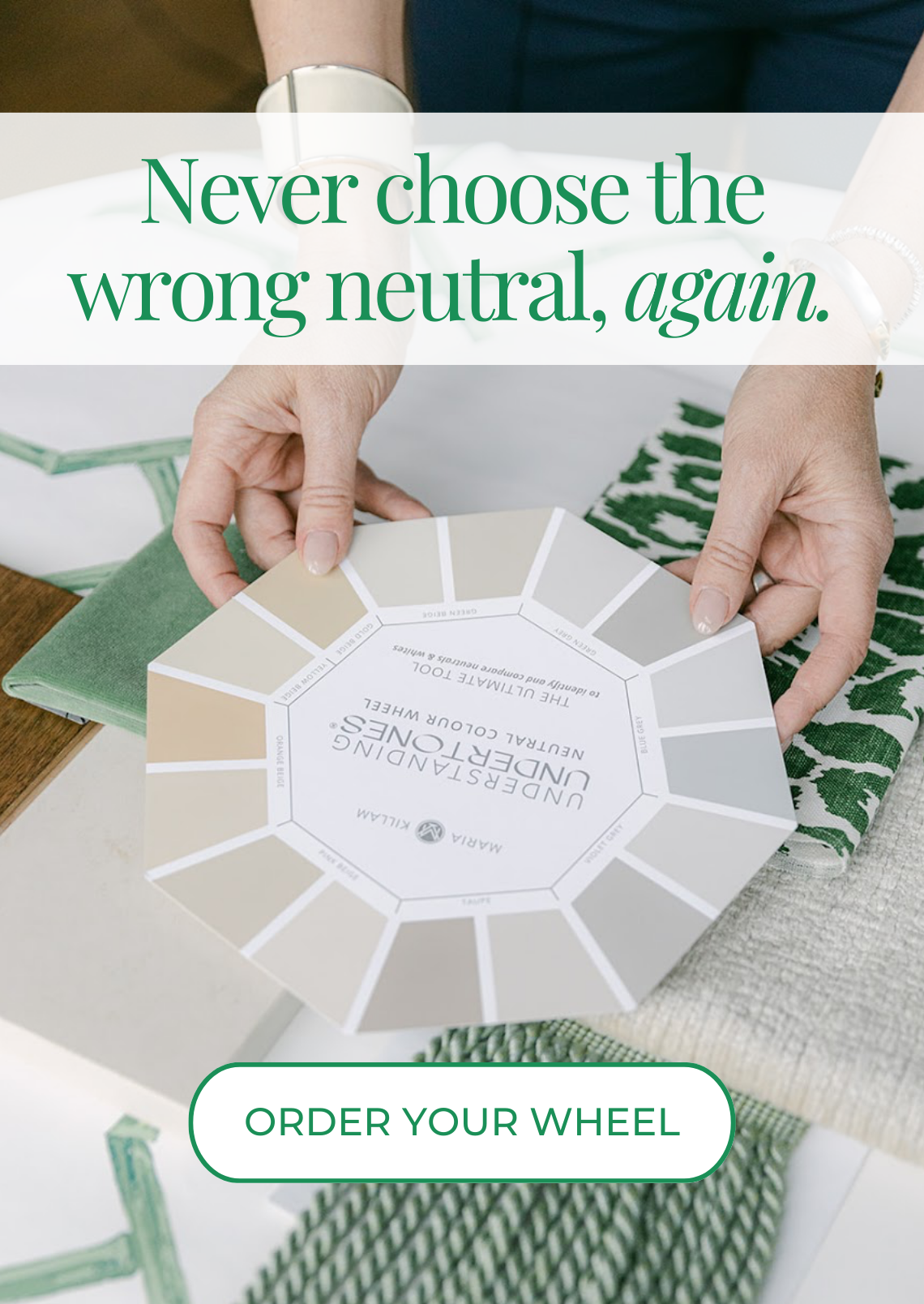This is another post from my genius Director of All Things Wonderful, Irene Hill. It’s been just over three years since she came into Terreeia’s and my life and we cannot imagine being without her.
“For those of you who have been following Maria’s fabulous blog for awhile, you probably read the Two Magic Words post I wrote in October of last year about the huge renovation rebuild my husband and I are suffering through bonding together through.
Fast forward nine months and our two-bedroom, second-storey suite (the whole reason for the rebuild) is complete. And beautiful. We actually gave it a trial run by living there while we were completing the insidiously dusty job of drywalling the entire main house.
We loved living in this new 1,100 square foot suite! The space is light-filled, a nice breeze flows through the great room, it’s cheap to heat as the gas fire warmth from downstairs helps keep upstairs temperate. And, of course, it’s pretty because we made sure all the finishes followed Maria’s classic and timeless principles: mid-tone laminate flooring, subtle-patterned countertops, subway tile backsplash, etc.

Everything was going great. We found an ideal tenant – a single mom and her darling 3 1/2 year old son who want to stay put in our suite for several years.
And then it was less great. Not because of our tenant and her little boy, but for reasons that could have given this post a headline like this — The Trials and Tribulations of Floating Laminate Flooring, or What You Should Know, But No One Ever Tells You, About Floating Laminate Flooring.” I could go on and on, but you get the point.
To be clear, there’s an important distinction between hardwood flooring and laminate flooring. Hardwood is, obviously, made from real wood that grew on a real tree at some point in its lifetime.
Laminate flooring on the other hand is a “multi-layer synthetic flooring product fused together with a laminate process that simulates wood with a photographic appliqué layer under a clear protective layer. The inner core layer is usually composed of melamine resin and fiber board materials.” Thank you Wikipedia.
The floating part comes when the laminate floor doesn’t require glue to keep it adhered to the subfloor (that’s so old school). Nowadays, popular laminate simply “clicks” together and is kept in place by the locking system and the fact that all the boards are wedged together, never to part.
And therein lies the problem. Between the bottom of the laminate inner core and the top of the subfloor there is still enough of a space to create the most amazing echo. Amazing, that is, unless you are living below it. And this was coming from a 110-pound young woman and a 45-pound little boy who really like us and aren’t stomping around with any kind of bad mood.
Before you rush to judgement leave a comment below, let me tell you how hard we worked to ensure there wouldn’t be any echo and we wouldn’t be able to track a sweet little boy’s footsteps as he enthusiastically runs from one end of their house to the other. A lot.
The first thing you’ll be told when you purchase a floating laminate floor is the thicker the laminate board, the quieter it will be. Ours is as thick as possible and 15 mm (which is the same type used in commercial application).
The next piece of advice you’ll get is to make sure you invest in an underlay padding. Unlike underlay for carpet, this particular type looks really thin but is specifically designed to cut the echo. We bought the best/highest quality/highest rated underlay in town. It was good.
Of course, what is between the floor above and the ceiling below will also affect any echo. If you have been following my rebuild story, you’ll remember that we took the roof off of our bungalow and built a brand-new second story. The mechanics of this were that we left the original ceiling joists in place, left an area that we stuffed with rockwall insulation (designed for soundproofing), built an entire new set of floor joists above this and even installed “rez bars” (resilient channels that run between the bottom of the joists and the top of your drywalled ceiling).
Did you follow all that? It really doesn’t matter – what matters is we did everything possible to be soundproofed but we still hear every footstep our tenants make!
You don’t need to send cards and letters— we’re working on a fix, but it got me interested in how other people deal with this. I found that this is becoming a hot new issue, especially in multi-storied apartments and condos. Home owners in these type of buildings are all getting the bug to rip out the ubiquitous wall-to-wall carpeting and install the look of a wood floor for a fraction of the price. Plus, any reasonably handy person can install it themselves. What’s not to love?
But, because of the echo (thudding, sound of a small herd of elephants) most floating laminates create, more and more strata board members find themselves writing new by-laws governing how and what and what needs to be in place before a homeowner may install floating laminate floors.
So, what are we doing to fix it? We haven’t settled on the final fix but one option is to provide serious area rugs throughout the entire main part of the suite. And not just dinky area rugs that only sit under the furniture. We need area rugs that cover all the traffic paths throughout the hallway and great room.
The actual size of rugs we’ll need to have for these areas are not standard sizes so that option is out. We’re left with buying carpet off a roll (maximum 12′ wide) and having each piece bound on all four sides. I’m concerned that won’t make enough of a difference as area rugs don’t usually come with underlay.

A second option we’re considering is taking out the “guts” of the laminate flooring and just leave a 14″ border of laminate around the edges. This will create a poor-man’s wood floor look as we’ll then install carpet tack strips in the centre and have 10-pound underlay and carpet installed.
Neither option is cheap. But perhaps that’s the price to quiet the lovable elephants that live overhead.
Over to you. Have you lived with noisy laminate flooring. What have you done or would you do to quiet down the noise from a laminate floor overhead?”
Related posts:
Wood Flooring in the Bathroom – Yay or Nay
The Most Timeless Laminate Flooring
If you would like help creating a palette for your home, become a client. Online or In-person.
To get your exterior colours right, download my How to Choose Exterior Colours with Confidence webinar and get my go-to list of colours.
Download my eBook, How to Choose Paint Colours – It’s All in the Undertones to get my complete step-by-step system on how to get colour to do what you want.
To make sure the undertones in your home are right, get some large samples!
And, if you would like to learn how to choose colour with confidence, become a True Colour Expert.




















Oh dear. What a tale; and with all your best efforts. SIGH. I am looking forward to reading solutions to this one!! Wall to wall carpeting starts to look better 🙂
OK…Help! I am about to step out the door with tile samples in hand to replace the laminate flooring in a rental condo we own that was destroyed by a water heater leak. Neighbors have all installed 18″ x 18″ travertine or quartz. I am worried about the coldness, hardness and loudness of tile…but carpet looks old too quickly in a rental. I just put wood-grain porcelain floor tiles in my laundry room and it looks great. How would wood-grain tile look throughout the living, dining and kitchen areas?
As long as it actually looks like wood, so many of them don’t. Maria
I feel your pain, Irene. We went with a thick area rug with padding underneath (every little bit helps). I hated to cover it up since it looked so pretty, but the echo was driving me batty! While it isn’t perfect, it does help some. Now we just have to find a good,strong vacuum cleaner! Hope you find a solution!
We had THICK carpet and padding installed. It was impossible to easily push our vacuum over the carpet – I bought a Miele and must say it is the best vacuum I’ve ever used.
I too love my Miele.
I love my Miele too.
It certainly sounds like you covered all the basis, so I am sorry to hear about your dilemma. IF intent on keeping the laminate flooring; I am wondering if it is possible to add an additional underlayment and if it would make any difference in controlling acoustics? Hopefully there are some flooring experts out there that can come to your rescue. -Brenda-
Second thought Irene, you might want to consider logging on to the website soundproofcow.com and under the title of ‘soundproof a …..’; there might be some information that will assist you. -Brenda-
P.S: Products and info contained therein are for Recording Studios.
Sorry to hear about your troubles. I lived in an old renovated condo with its original hardwood floors. The neighbor downstairs asked me not to wear my heels.
Take a look at FLOR carpet tiles. They have a great backing and are extremely flexible. Also very stylish and easy to clean. I’ve had great results with them.
Agree–FLOR is a great product! I love that you can re-configured tiles into whatever shape/pattern you want. I have found customer service to be amazing. If you call an actual store and have them create a ‘design’, shipping to and from your home is free. That’s becomes important if the product does not work and you have to return! The Atlanta GA (USA) store sent us full size samples from their ‘library’; really helpful! We already have FLOR in two spaces and are about to install another 800 square feet… It’s perfect for DIY. Georgette Mosley at Atlanta, GA, USA store was so much help to us. Good luck, Irene!
Irene, I think the idea of Flor carpet tiles is a good one. They are padded on the back and the other nice thing about them is if one gets damaged (spilled on) you can replace just that one.
Another idea is vinyl planks. They are quiet, water resistant and also very easy to install. I know you can get them at Home Depot (not sure if you have HD in Canada). It would mean removing the other floor but it would be a permanent solution. I plan to use vinyl plank for my family room. I had laminate at my last house and I didn’t like the hollow sound it made.
Good luck!
So sorry to hear this. I wish I had a suggestion for you. Seems you got t covered though. We just tore out all of our carpet and tile on our main floor and opted to use luxury vinyl planked flooring. It doesn’t have the hollow sound everywhere but there are a few spots where you can definitely tell the floor is not completely flat. We liked the “waterproof” flooring benefits over laminate. With 2 small kids, 3 cats and a dog you can never be too careful.
Sounds like wall to wall carpet over the laminate floor in the main living areas, with a good thick pad is the best/worst solution. It is probably less expensive than buying the carpeting and having it bound and would add to the sound proofing. So sorry for the headache this has caused! Thanks for sharing. (I have oak floors on my entire second level and we do not have this noise problem)
Have you considered cork flooring? Again, not inexpensive at this point, but supposed to be great for sound absorption. We just installed engineered wood floors throughout the upstairs of my house, and the installer used a special(and very expensive) glue to reduce sound. It made a huge difference.
I agree with using cork. Have it in our kitchen, and although there is no one below that level, it is very quiet, comfortable under foot, and naturally warm too. I’d go this route for a much more quiet floor than hardwood or any plank or click-flooring.
My vote is also cork which I have in my entire 3rd fl. that is a rental. QUIET and easy to clean. It’s been use in museums and libraries for 100+yrs and has many beautiful colours and styles to choose from. You could put a floating floor directly on top of the current one with another absorption layer in between or get the glue on squares. I used the former over the original pine and all that cork just absorbs the sound.
Hi Irene, I third the notion of a cork floor. We had it in a Florida house and not only was it quiet, but easy to clean and dropped a stemmed wine glass on it once–didn’t break! Fortunately we didn’t loose any of the wine either! Haha.
Excellent post and love your writing style, Irene. Looking forward to the suggestions and discussion here. Thank you.
Will be following this thread with interest, as my large and somewhat clumsy father-in-law’s living area is directly above my infant son’s bedroom. We have a wool rug with double thickness padding upstairs and a white noise machine downstairs for sleeping. The rug is a tripping hazard and I’d like a better solution.
Soundproofing ceiling tile in your space might work.
What a disappointment after all the precautionary steps you took! FLOR carpet tiles would allow you to customize sizes & shapes: runners, squares & rectangles of any size. But it won’t be cheap. Thanks for the warning. A sort of related question is: are the tenants aware of hearing the flooring click as they walk on it? I’m considering a laminate floor for my basement & wonder about floating vs. glued down.
We have a laminate ‘wood’ floor in part of our basement only and, yes, it does make a clicking sound when you walk on it. I would not want it on a main level or any place with living space beneath. (The basement space with laminate also tends to echo more than the basement room that is carpeted, which is MUCH quieter and more comfortable.)
Another observation: our previous chalet-house’s interior was all wood – cedar tongue-in-groove cathedral ceiling, cedar walls, hardwood floors. Only carpet was an area rug in the main level and wall-to-wall carpet in loft and bedrooms. But it was a much quieter house than our current home, which has hardwood and ceramic tile in main areas, carpet in family room and bedrooms, but drywall walls and ceilings. I can’t imagine how noisy it would be if we had laminate floors! This is a relatively new house – which does not insulate interior walls; i am thinking of drilling holes and using spray foam insulation in at least the bedroom walls to cut down on the sound transfer.
Follow-up, take a look at Green Glue compound.thay have a web-site with videos. You simply add a second layer of drywall to your ceiling with the Green Glue and they claim it reduces sound up to 90% . Worth a look, simple for DIY.
glad you mentioned ceiling, yes THAT could probably solve the problem for you.
perhaps it is the actual construction itself, and not the laminate so much.
attacking issue from both sides (LOL) will probably result in better solution.
good luck!
Cork flooring is probably the best option if you don’t want carpet.
Oh my…it probably looks so lovely too and I can imagine the sound is enormous.
I love following your stories and look forward to your ‘fix’!
As Debbie says, ceiling solution might be a another good option.
Also, is it possible to glue down the laminate?
I looked at laminate for our first floor and “didn’t like the sound of it.” Can’t imagine the sound from above. Good luck with this dilemma.
Thank you so much for sharing this post. I have many clients who have talked about laminate flooring and now I will be much more educated to the downfalls beyond the typical “bounce” many of them have had after being down several years or not properly installed. Truly great to find this kind of information passed along because I never would have guessed echo to be an issue since they have underlayment.
All that work and this to deal with – I wish there was a magic wand to make it go away!
I wonder if you might still get some elephant herd noise if it was a solid wood floor. In the past I lived in condos with concrete between floors with carpet on top, and could easily hear my upstairs neighbors’ hard little heels banging through.
In our own home, our cats – small animals with puffy feet – are referred to as the cat-ponies when they run upstairs, because from the floor below, it sounds as if they have hooves.
Good luck, Irene.
All the condos we’ve lived in required 80% coverage of hardwood flooring by area rugs. It was in the documents. Would real wood or engineered wood still produce the echo or is this condition unique to laminate? What about gluing the laminate to a plywood subfloor?
Very interested to read any possible solutions. We have a similar problem, but in our case the flooring is ceramic tile with underfloor heating. I always assumed it was the cement layer that the electrical lays in which creates an amplification of sound transmission. People in the suite belie complain about those above wearing hard soled shoes, but I know the don’t.
When we first got married, we made the mistake of leasing a first floor apartment. We called the woman who lived upstairs “Clippy Cloppy” because you could hear EVERY step she took when she had her heels on. LESSON LEARNED: Only live on the top floors in future or buy one story homes. Our current house is a 2800 sf one story home. We’d like to move but it’s almost impossible to find a larger one story home where we live!
It’s obviously not on trend, but five years ago we installed very high quality, low pile carpeting in our family room. We love this carpet and are considering it for our new house. It’s warm (we live in the PNW) and comfortable, if you spill water on it it beads right up, our 2 and 5 year old play on it hours a day and it looks brand new.
We have engineered hardwood in our living room and I don’t like it at all; constant dusting, worries about spills, etc. Personally, I’d rather vacuum and welcome a really good carpet cleaner once a year who was recommended by my carpet guy and does a wonderful job.
Again, I know it’s not trendy, but I do think nice, low pile, cut loop wall to wall is worth consideration.
Two words: Cat barf
Two more: Older cat
I hate carpet! 😉
I said I wouldn’t change it until after but she’s back to good health.
Sorry to hear this, Irene. I just installed the hardwood lookalike laminate flooring in my basement. No problems there with noise, of course. Love the look and low maintenance. I hope you find a solution!
Are your tenants wearing shoes? Socks & bare feet shouldn’t have such an impact? I realize that’s a bit of an infiltration on the way they live, but if you haven’t tried that yet, maybe worth the experiment? Good luck!!
Just a thought anyway you could soundproff your ceilings might be less messy and disruptive . You can get some wonderful new products that cutout a lot of sound , go up instead of down ? Good luck and hope everything works out .
I understand that the laminate & installation is part of the problem but not all of the problem. We installed regular hardwood upstairs in our last home. I fostered a set of 5 kittens from the age of 6 weeks till they were close to 3 months old… so they were 2 – 3 lbs at most. I remember posting on Facebook “the herd of elephants, I mean kittens, are romping upstairs”. If you can hear a kitten running, then you can hear anything.
Hi Irene! So sorry to hear about your predicament! I am an architect and have some experience with acoustical assemblies in commercial buildings. The assembly you used for the floors looks right on. 1 option, if you have the height, would be to add another layer (or two!) of gypsum ceiling board to your ceiling. This will add more mass to your ceiling, which will prevent sound transmission.
So here’s the scoop, I’ve been in the flooring sales for going on now 17 years. I live in Honolulu otherwise known as the laminate capitol of the US. Sound ratings are are important as you pointed out.
Newer Condos have less space between floors than older buildings so it is a problem. Condos here have sound ratings listed in their condo docs, I only sell Silent Blue which has a 72 IIC sound rating. People in Hawaii don’t where shoes in the house as we have a large Asian culture. I change into slippers (flipflops) the second I walk in the house because hard surface is hard.
I am also the queen of low maintenance. Laminates are easier to clean that’s why they are so popular here our windows are open all the time. No AC or heat for 28+ years. At the last Surfaces convention (new flooring products) no new laminates were introduced, only vinyl planks. My favorite company for vinyl planks glue down or loose lay is definitely Karndean hands down. It’s super durable (spilled a whole bottle of bleach on it, no damage)and they have some good patterns.
If your looking to buy a new vacuum and you have carpet don’t buy a Dyson. All of the major carpet mills Mohawk, Shaw, Beaulieu, etc. will void any warranties if you do. Dyson’s suction untwists the fibers and the carpet will not wear as well. Check out the Miele vacuums they are made in Germany. Mohawk has issued a list of approved vacuums and several of the Miele vacuums are on there.
Hope this helps.
That was helpful. I just did a kitchen where the couple moved into it and renovated at the same time. They were mad at the carpet installation people because they spliced a section in the living room at the entry in the opposite direction with the pile so it was an eyesore. Then they said the carpet people told them their vacuum was too strong. I thought that sounded silly since a vacuum is supposed to suck, but now I know.
I was planning on using the 72 db pad with an engineered floor. Hope that’s okay. My downstairs neighbors are weekend people. I have a cat and am barefoot so I don’t step on paws or track in dirt.
LOL! Same clients with the messed up carpet just called to do their 30 yo bathrooms about an hour ago. Her ears must have been burning!
Yup! That’s one of the reasons all the original oak floors got covered with carpeting before the latest trend. Thick carpeting and padding seriously cut down on the “noise factor” of wood floors.
Irene, after all the careful effort it must be so distressing and I can imagine you’re reluctant to try more “fixes” such as adding insulation or different glues if you don’t have guarantees and having oversized area rugs produced can be overwhelming too. That’s why I think the FLOR carpet tiles are kind of brilliant. Not cheap either but they’re fast and easy, there are tons of colors and patterns, and you can probably buy 2 or 3 boxes and lay them out in an area just to try before you stick them down. If they solve the problem, then they do become an easy and relatively cheap fix, much less disruptive to your renters, you and they have variety and choice (in fact, they probably would enjoy helping to choose and to install), and you and your husband have time to sit back and follow what other fixes are being developed for what is apparently a big problem without wasting any more effort of your effort or money. Good luck!
I’ve already commented on FLOR tiles but did not think to mention specific of install: You do NOT adhere the product to the floor. FLOR provides adhesive ‘dots’ that you can stick to the back of tiles where 4 tiles join. That holds the tiles together so there is no slippage. We installed the product as ‘wall to wall’ and skipped the dots and have been fine without them. Again, work directly, by phone, with a FLOR store to avoid any cost for a return–pretty risk-free for a ‘trial-run’! You can check their web site for more detail re: installation, product. Compared to other products–ease of installation & maintenance, durability and versatility, no need for pad–we think the cost is reasonable 🙂
We have a daylight basement where just over a year ago we installed, okay, I am not sure what the exact type of “wood laminate” the flooring is called, but we were told NOT to install REAL WOOD flooring over the cement in this area. So, in our daylight basement are two bedrooms, a family room and bathroom. (There are also a couple of storage areas for a hot water tank and such.) I do like the flooring. We have gorgeous real wood flooring on the second floor, which is our main living area. If I ever sell this home, I think I should make certain the real estate agent reads this article, because it is my understanding that there are places real wood should not be installed, and wood laminates are the best choice for some areas. (Or do real estate agents just avoid mentioning these types of things?)
Thank you for your honesty in this article,Irene-I have no advice, but am feeling like i dodged a bullet-My Uncles renovated condo has all laminate floors downstairs and we put laminate in his large loft room upstairs where he paints-he is an artist-Thank god it is over the garage-yahoo!! We are planning on selling it next year, so at least we won’t have any flooring issues with potential buyers.
Most hard surface, real wood, laminate, vinyl,
and tile manufacturers only warranty a floor that meets a moisture rating of 3lbs or less. Basements are often over that especially if they are below grade. (below ground level). Moisture abatement is possible but costly. If you have a moisture test done and it’s over 3lbs. don’t glue. A floating floor is a better choice. Laminate or floating vinyl anything that doesn’t require glue. If there is too much moisture the glue will fail.The reason floating vinyls have become so popular is because of open floor plans. The most common claim with insurance is when the dishwasher overflows or the water line to the automatic ice maker fails, if laminate is installed it has to be replaced. Sometimes years after the laminate pattern is discontinued. Tile for a lot of people is too hard. That is why the vinyl planks are so popular now.
If you are installing a real wood floor a glue down is best for sound. You can glue to a concrete sub-floor
but it should first be treated for moisture. A wood sub floor is an easier install. If your installer wants to float a real wood floor because it’s easier for him and glue can get expensive. The sound issue may be the result. My store does not sell Flor, my landlords prefer to just use bound remnants they are cheaper and can just be tossed when someone moves. You can use double stick carpet tape around the perimeter to avoid tripping hazards it won’t hurt the laminate. Alcohol or mineral spirits can get rid of tape residue. Hope that answers your question.
I’m in a condo building and as per our documents whenever flooring is being replaced with tile or laminate a layer of cork needs to be installed first to help absorb noise, however, I don’t think our neighbors followed that rule when they installed their laminate flooring. We are directly below them and I hear EVERYTHING. I feel your pain and am so sorry you are dealing with this especially with the vast research you put into the flooring so everything would be just right. The only solution that I have come up with at this point is white noise. I bought a bose speaker which I play Pandora from when I don’t have the TV on and at night I sleep to rain with another bose speaker I bought for my bedroom. It does help as I now focus on the music rather than people with shoes walking across the floor or their running water or their doors closing or worse peeing,,,,,yes, its that bad! I would think large area rugs would be a huge help to you as well. Good Luck Irene!
Hi Irene, I don’t have any advice to offer up but I completely sympathize with your noise issues. When I was young, I lived in an apartment below a family. I could hear them all the time. It drove me crazy. Moving was my only salvation.
Good luck coming up with a solution.
I am an acoustical consultant. Laminate flooring does not create an “echo”–the space between the flooring and the subfloor is not large enough for that. There are two basic things operating here–the laminate floor is lighter than the equivalent hardwood floor (mass is important in providing acoustical isolation) and the fact that the laminate is not secured to the subfloor results in a double impact (first when the foot hits the flooring and second when the flooring hits the subfloor). These two factors increase the isolation problem with laminate flooring. However, any hard floor surface will make isolation difficult, because getting vibration out of the floor construction is much harder than keeping it from getting into the floor in the first place. That is why carpet is effective–it softens the impact of feet so that less vibration gets into the floor. Also, the installation of resilient channels has to be done just right in order to be effective. It more often than not is not done right and the isolation of the channels is short-circuited. There also must be an airspace separating the underside of the floor assembly from the top of the ceiling assembly below–the deeper the better. By deep, I mean at least several inches and as much as a foot is not too much. The space should be filled with glass fiber building insulation to absorb sound that makes it through the floor. The best approach is to construct a totally separate ceiling below the floor using 2×4 construction attached to the walls with no contact to the floor assembly above. 2x4s are usually satisfactory but 2x6s may be needed if the span is very long. Then install the fiberglass and at least two layers of 5/8″ drywall (mass is very useful here). This will be much more effective than using resilient channels. However, note that there is no such thing as “soundproofing”. You can only provide a reduction in sound levels, hopefully a large reduction. If it is very quiet in the room below you will be able to hear impacts through even very good construction. In a case such as that you may need to provide sound masking in the room below. This is a low level of random noise generated electronically that covers (or “masks”) the sound coming from above. However, the usual masking generators you can buy on the Internet will not be satisfactory, because they do not generate much, if any, sound at the very low frequencies where impact noise from footfalls is dominant.
Good luck.
Irene, did you use “resilient channels” or “resilient clips + channels”? From what I’ve read, the former are not nearly as good as using the clips. I’d try Green Glue and a layer of 5/8″ sheetrock on your ceiling. Keep in mind I’m not speaking from experience, just from research I’ve been doing to try to avoid this issue when we finish a basement bedroom in the future. Good luck!
Hi !
I’m going to second a combo of two tips above , which worked for us . We had a 3 1/2 pound dog sounding like an entire herd of buffalo ,and her tiny toenails sounding like they were typewriting while thundering by .
We had to use a two sided fix , both a Green Glue + drywall applied over the existing Gyproc /resilient channel ceiling ; AND glue down the previously floating floor . Solved .. phew !
I don’t have an answer but I can tell you when I stay
in the basement bedroom of my friends expensive, fabulous new home that has the kitchen table above
me I can hear every scraping sound of the chairs and
every step. They have ceramic tile on the floor above
the guest room…………so it does the same thing. And
even when I lived in apartments that had carpeting on
the floors of the apartments above me I could still hear
loud laughter and squeaking when people walked so
I seldom rented 1st floor apartments and that was in
ALL apartments…….even the ones that were built well.
Best of luck to you with the noise issue……..hope
you can find a solution and let us know what it is.
I have an upstairs apartment that I rent out that I renovated. I used 3/8 inch thick rubber as an underlayment with some cheap laminate on top of that. The rubber was not cheap and was very heavy. It worked so well that when the new tenants moved in, I could not hear a thing. I actually thought that they had died up there so I went to check on them. They were fine. The flooring was so cheap that after a few years, the moisture started to eat away at the floor finish. I will soon remove that flooring and install vinyl over the rubber. I am also thinking about cork over the rubber.
Haha that’s funny, great comment thanks! Maria